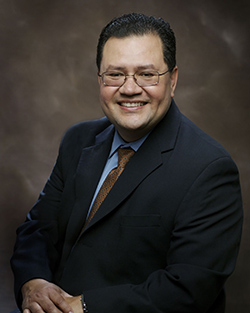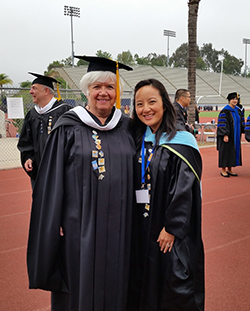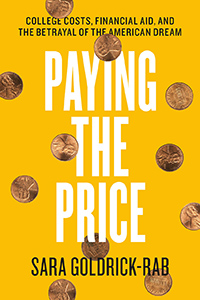 League Releases Report on Federal Work-Study and California Community Colleges
League Releases Report on Federal Work-Study and California Community Colleges
The California Community Colleges are the largest system of higher education in the United States serving approximately 2.2 million students across 113 campuses. The state’s community colleges provide multiple forms of federal and state funded financial aid. One form of financial aid is Federal Work-Study (FWS), created for students who require income to defray the costs of their education while encouraging recipients to participate in community service activities that benefit their local area.
A September report by the League, The Federal Work-Study Program and the California Community Colleges, found that the discussion of next steps should include college-based recommendations such as a public information campaign for increasing FWS applicants as well as recommendations for future research and empirical studies to develop a robust body of evidence regarding FWS, utilization trends, and measures of student success. In this research it has become clear that: 1. There is a lack of in-state empirical research on work-study utilization trends, 2. There still seems to be a level of awareness building for California Community College students demonstrating that they would benefit by filing a FAFSA regardless of intent to accept aid, 3. California policymakers and officials would have increased decision making ability if state funding data for community colleges also provided comparison data for awards applied for and used. Read the full report.
Board Member Spotlight
CEOCCC Board Member Marvin Martinez
“I think I first started training for a college presidency while growing up as a middle child in a family of eight. In such a large family I learned a thing-or-two about negotiation: imagine trying to agree on a Friday night movie.”
Currently in his fourth year as president of East Los Angeles College after serving as president of LACCD’s Harbor College beginning in 2010, Marvin Martinez describes his career path as “a fairly non-traditional one.” Martinez is also a member of the Chief Executive Officers for California Community Colleges (CEOCCC) board.
 After graduation from UCLA in 1988 with a B.A. in English, Martinez became a research fellow for California Tomorrow, an organization advocating for equity and inclusivity across California. Martinez describes the work as centered on reporting on the impact of immigrants in public schools. Following a presentation at Cal State Dominguez Hills, Cerritos College Trustee Dr. Ruth Banda-Ralph encouraged Martinez to apply for a position at Cerritos coordinating their amnesty program and he was selected for the position. Following this, Martinez made his first foray into CTE at Cerritos and in 1993 – at the age of 24 - he became dean of Business and Industry at Santa Monica College.
After graduation from UCLA in 1988 with a B.A. in English, Martinez became a research fellow for California Tomorrow, an organization advocating for equity and inclusivity across California. Martinez describes the work as centered on reporting on the impact of immigrants in public schools. Following a presentation at Cal State Dominguez Hills, Cerritos College Trustee Dr. Ruth Banda-Ralph encouraged Martinez to apply for a position at Cerritos coordinating their amnesty program and he was selected for the position. Following this, Martinez made his first foray into CTE at Cerritos and in 1993 – at the age of 24 - he became dean of Business and Industry at Santa Monica College.
Martinez explains that his VP at Santa Monica was Darroch “Rocky” Young, who along with President Dr. Piedad Robertson, became strong influences. In the late 1990s, Martinez was promoted to VP of Planning and Development where he served until moving to the presidency of LACCD’s Harbor College in 2010.
Asked about what he enjoys most about his role as president, Martinez responds, “being able to make change.” Martinez points to his successful leadership resulting in the elimination of a decade-long deficit at Harbor College and a $1.5 million surplus by the end of his third year. Martinez explains that he especially enjoys bringing people together to achieve consensus.
Concerning the most significant issues confronting California’s Community Colleges, Martinez identifies persistent inequity in graduation and transfer, and declining enrollments and budget considerations. Martinez acknowledges that there is some improvement, yet observes “we are still a long way from being able to say that students of color and the economically disadvantaged have the same chance of graduating or transferring from our institutions as other students.” President Martinez highlights East Los Angeles College’s Greater Outcomes for East Los Angeles (GoELA) program as a successful effort that has moved the college’s transfer ranking to CSU and UC up from 20th for each system to numbers 15 and 12 respectively.
President Martinez identifies political science, history and English as his preferred subjects as a student. He expresses a fondness for Hemingway and Steinbeck, and views literature as an important means to understanding the perceptions of others.
When not busy with his presidential duties at East Los Angeles College, Martinez remarks, “My number one job is being a husband and a father. He continues, “When I’m not busy with the presidency I enjoy watching my kids at soccer practice.”
Despite the tremendous challenges facing community college presidents, when queried for advice he’d give to people considering a career in community college leadership Martinez responded, “There’s never been a better time to pursue a career in community college leadership.” He points to the high profile of community colleges at the federal level, as well as the “looming leadership vacuum with many presidents and vice presidents nearing retirement,” and therefore the need for strong leaders in the years ahead.
More specifically, Martinez recommends those interested in a community college leadership role should not be afraid to move around as it offers a broader perspective of a variety of campus and institutional cultures. He also expresses the importance of finding a mentor and role model. And finally, Martinez explains how critical it is to believe in the cause and the mission of the community college. In his own words, “my cause over the years has centered on providing access to all our students and then ensuring that those same students will be able to graduate or transfer.”
Finally, Martinez observes that while not everyone can or would like to be a college president, every level of community colleges requires effective leadership and contributions from individuals with a passion and pride in our mission.
CCCT Board Member Sue Keith
Citrus College Board President and CCCT Board member Sue Keith’s passion for public higher education and student success is informed by her personal experience as a student at Lassen Community College; her recognition and gratitude for the support and sacrifices of her Irish and Italian immigrant grandparents; and the breadth of her experience as a trustee at both the K-12 and community college levels.
 Sue Keith has served on the Citrus Community College Board for 17 years and is enjoying her second term as a member of the statewide CCCT Board. Citrus College is located in the city of Glendora, and is the oldest public community college in Los Angeles County.
Sue Keith has served on the Citrus Community College Board for 17 years and is enjoying her second term as a member of the statewide CCCT Board. Citrus College is located in the city of Glendora, and is the oldest public community college in Los Angeles County.
Asked about how she first became interested in supporting the community college mission, Trustee Keith explained, “During my senior year in high school, my family returned from living in France for two and one-half years and was stationed at an army base in rural Northern California where she traveled by bus to attend Lassen.” That experience has led to her strong support for the community college baccalaureate degree as a means to increase access for families in rural communities.
Board President Keith was the first person in her immediate family to attend college, and she explains that her father’s plan to pursue higher education was “interrupted” by World War II. Trustee Keith points to this as an example of the sacrifice her family members made and is a primary reason why she believes so firmly that it is her responsibility to pass on the opportunity higher education affords to current and future generations.
Sue Keith’s leadership role in public education began with her service on the Board of the Claremont Unified School District where she served for 12 years. Combined with the 17 years she’s served the Citrus Community College District, Keith has nearly 30 years as a public education leader.
Queried about the most important issues confronting California’s community colleges, Trustee Keith cited the need to secure more resources to meet the most important goal of enhancing student success. Illustrating her understanding and appreciation of the historical sweep of the work of community colleges, Trustee Keith identifies the impact higher education attainment has on entire families and successive generations. Describing her perspective as a trustee, Keith explains, “Our work requires thoughtful policy-making, planning, and implementation in a respectful and participatory environment.”
When she’s not serving on the CCCT and Citrus College Boards, Trustee Keith enjoys spending time with her grandchildren, family, and friends; as well as traveling, gardening, bike riding, reading, and attending social events in the community. Yet more often than not, you will find Sue Keith supporting students and advancing the mission of Citrus Community College.
Recommended Reading
Paying the Price: College Costs, Financial Aid, and the Betrayal of the American Dream
by Sara Goldrick-Rab
University of Chicago Press – 2016
Available for purchase from Amazon (click here).
 If you have followed the public discourse concerning the benefits and possible pitfalls of “tuition-free higher education” or “free community college” then you are likely familiar with the name and work of Dr. Sara Goldrick-Rab, now of Temple University, and formerly of the University of Wisconsin, Madison.
If you have followed the public discourse concerning the benefits and possible pitfalls of “tuition-free higher education” or “free community college” then you are likely familiar with the name and work of Dr. Sara Goldrick-Rab, now of Temple University, and formerly of the University of Wisconsin, Madison.
Dr. Goldrick-Rab is likely the only professor of higher education policy and sociology ever to have been a guest on The Daily Show, and she has both passionate followers and detractors[1]. Regardless of your familiarity or perceptions of Dr. Goldrick-Rab, her recently published work: Paying the Price, is a highly informative and well-researched work on what she refers to as the “new economics of college in America” (p.1).
The book effectively weaves together quantitative and qualitative data from an extensive six-year longitudinal study known as the Wisconsin Scholars Longitudinal Study. The student sample included 3,000 randomly selected college students enrolled in all public two-year and four-year institutions in the state of Wisconsin (p. 265). The sample was comprised of Wisconsin public high school graduates enrolled full-time in a Wisconsin college or university in fall 2008 who were Pell Grant recipients, and who still had a minimum of one dollar of remaining unmet need. Although the researchers sought to increase the percentage of students of color to more closely mirror demographics of public college and university students nationwide, the full sample consisted of 35 percent students of color versus national data showing 55 percent of public higher education students identifying themselves as either Hispanic, African American, Asian or Other (p. 267). Fifty percent of the students sampled began at a community or technical college in Wisconsin, and 58 percent were female (p. 267). The average adjusted gross income of the parents of the students was approximately $25,000, and the mean age was between eighteen and nineteen years old. Goldrick-Rab points out in the Appendix describing the methodology that the sample for the study was generally representative of the national population of first-time, full-time Pell Grant recipients attending public institutions save for the racial/ethnic composition of the sample (p. 267). Additionally, although half the students attended a community college, the sample skewed younger than public community college students nationally.
This a timely book considering the research documenting that having only a high school diploma places individuals at a significant disadvantage in the current labor market and for years to come. As economists cite the need for higher education attainment for individuals, states and nations, since 2000, tuition alone has increased 28 percent at community colleges and 54 percent at public universities nationwide (p. 2). Goldrick-Rab observes that since 2003, the mean family income of all save the wealthiest five percent of Americans fell or stagnated (p. 3). Thus 75 percent of families now pay at least 20 percent of their annual income for higher education (Ibid). Moreover, merely 48 percent of all Pell Grant recipients attending public colleges and universities complete a degree or certificate of any kind within six years (Ibid).
Goldrick-Rab skillfully unpacks the issues germane to understanding the higher education landscape in the US - and in particular the challenges facing low-income students - by chronicling the educational journeys of six students presented as somewhat representative of the thousands of students she and colleagues have studied in the years following the Great Recession.
Paying the Price will satisfy those eager for a well-researched and comprehensive understanding of college affordability and the complexity of the system of financial aid in the US. The narratives of six students struggling to improve their lives via higher education assist the reader in understanding how the financial aid system affects low-income individuals with myriad challenges and obstacles in their lives. Although those of us working within public higher education are intimately familiar with the issues confronting low-income students, Paying the Price offers policymakers and citizens believing that the typical student is 18 years-old, attending full-time, living in a dorm, attending football games, parties, and perhaps working 10 hours a week, a much-needed dose of reality.
Goldrick-Rab argues that the more than 50 year-old system of financial aid is outdated and requires significant systemic changes to address contemporary circumstances. Importantly, the author documents that non-tuition costs: living costs, transportation, childcare, books and supplies constitute between 50 to 80 percent of the total sticker price for students (p. 41).
In addition to unpacking the financial system and detailing the new economics of higher education in the US, Goldrick-Rab chronicles food and housing insecurity among low-income students as significant. In 2015, Dr. Goldrick-Rab’s Wisconsin HOPE Lab research concluded that a survey of 4,000 undergraduates at 10 community colleges across the nation found that 20 percent are hungry and 13 percent homeless.
In the final chapter of Paying the Price, Goldrick-Rab advocates for making the first two years of public college free. Part of the reason for this is the rhetorical simplicity of the term “free” and the message it communicates to low-income families. Additionally, she addresses counterarguments for this proposal and details other policy changes she believes will increase the opportunities for low-income families and students to gain access to higher education as well as be more likely to obtain a degree or certificate.
The League is pleased that Dr. Goldrick-Rab will be a keynote speaker at our 2016 Annual Convention in Riverside, and I would highly encourage familiarizing yourself with Paying the Price as we all confront the challenge of increasing access, strengthening equity, and creating the conditions for quality public higher education in California and nationally.
[1] Milwaukee Wisconsin Journal Sentinel, January 21, 2016. “Reviled by some, revered by others, Madison professor pushes on.” Karen Herzog. Available online at: http://archive.jsonline.com/news/education/reviled-by-some-revered-by-others-madison-professor-pushes-on-b99649971z1-366093081.html.







